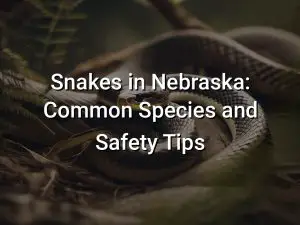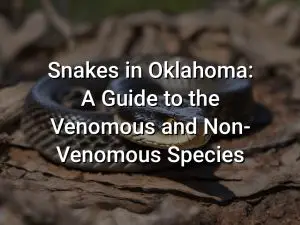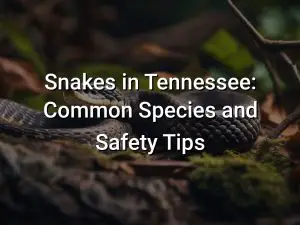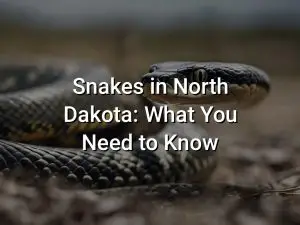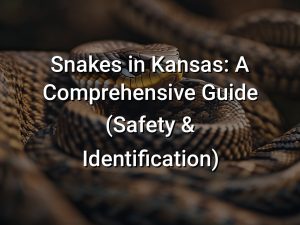Snakes in New Hampshire: A Guide to Safety and Identification

Are you curious about snakes in New Hampshire? Whether you are a seasoned herpetologist or just want to learn more about these slithering creatures, this guide will provide you with valuable information about snakes in the Granite State. From common species to safety tips and conservation efforts, we’ve got you covered.
New Hampshire is home to a diverse range of snake species, some of which are endangered or venomous. Fear not, we will also share snake identification tips and safety measures to help you navigate snake encounters with confidence. So grab your snake boots and get ready to dive into the fascinating world of snakes in New Hampshire.
Quick Links
Common Snakes in New Hampshire
New Hampshire is home to a variety of snake species. While some people may have concerns about encountering snakes in the wild, it’s important to remember that most snakes are harmless and play a vital role in the ecosystem. Here are some of the common snake species you may come across in New Hampshire:
- Garter Snake: Garter snakes are one of the most common snakes in New Hampshire. They are easily recognizable by their long, slender bodies and distinctive stripes or patterns. Garter snakes are non-venomous and primarily feed on small prey such as insects, frogs, and small rodents.
- Eastern Milk Snake: Eastern milk snakes are another common snake species in New Hampshire. They have a distinct pattern of reddish-brown blotches on a lighter background, resembling a milk-spattered appearance. Despite their name, milk snakes do not drink milk. They are non-venomous and feed on small mammals, birds, and reptiles.
- Eastern Ribbon Snake: Eastern ribbon snakes are slender and have a distinct greenish-gray color with a yellow or white stripe down their back. They are most commonly found near bodies of water, such as ponds or streams. Ribbon snakes are non-venomous and feed on insects, small fish, and amphibians.
- Red-bellied Snake: Red-bellied snakes are small and have a dark brown or gray color on their back with a red or orange underside. They are most commonly found in wooded areas. Red-bellied snakes are non-venomous and primarily feed on earthworms, slugs, and small invertebrates.
- Eastern Rat Snake: Eastern rat snakes are larger than most other snakes in New Hampshire. They have a black or dark brown color with a white or yellow underside. Rat snakes are non-venomous and are excellent climbers. They feed on small mammals, birds, and eggs.
If you encounter a snake in the wild, it’s best to observe it from a safe distance and avoid disturbing or provoking it. Remember, snakes play an important role in maintaining a balanced ecosystem and should be respected for their contribution.
Endangered Snakes in New Hampshire
While New Hampshire is not known for having a high number of endangered snake species, there are a few that are of concern in the state. These snakes are protected by state and federal laws due to declining populations and habitat loss. It is important to respect and protect these endangered species to ensure their survival for future generations.
One endangered snake found in New Hampshire is the Eastern Massasauga rattlesnake (Sistrurus catenatus catenatus). This small rattlesnake is characterized by its distinct rattle on the end of its tail. It prefers wetland habitats and is often found near marshes, swamps, and bogs. The Eastern Massasauga rattlesnake is rarely encountered by humans and poses little threat if left undisturbed. If you do come across this snake, it is important to keep a safe distance and avoid any interactions.
The Timber Rattlesnake (Crotalus horridus) is another endangered snake species in New Hampshire. It is the largest venomous snake found in the state, with adults reaching lengths of up to 4 feet. Timber Rattlesnakes are typically found in rocky areas and prefer wooded habitats. They are known for their distinctive rattles, which they use as a warning sign when threatened. If you encounter a Timber Rattlesnake, it is important to give it space and let it retreat to safety.
Conservation efforts are being made to protect these endangered snakes and their habitats. It is important to respect and appreciate the role that snakes play in our ecosystems, as they help control rodent populations and maintain a healthy balance in nature. If you do encounter a snake in New Hampshire, remember to observe from a safe distance and avoid any actions that may disturb or harm the snake or its habitat.
Venomous Snakes in New Hampshire
New Hampshire is home to two species of venomous snakes: the timber rattlesnake (Crotalus horridus) and the copperhead (Agkistrodon contortrix). While encounters with these snakes are rare, it is important to be informed about their appearance and behavior to ensure your safety.
The timber rattlesnake is the only venomous snake native to New Hampshire. It can be identified by its distinctive, diamond-shaped head, heat-sensing pits between its eyes and nostrils, and a rattle at the end of its tail. This snake can vary in color, ranging from gray or tan to yellow or brown, with dark, v-shaped crossbands along its body.
The copperhead, on the other hand, is a southern species that occasionally ventures into New Hampshire. It has a copper-colored head, hence its name, and a body covered in hourglass-shaped crossbands that become more distinct towards its tail.
If you encounter a venomous snake in New Hampshire, it is important to exercise caution and give it a wide berth. These snakes are rarely aggressive and will generally retreat if given the opportunity. Do not attempt to handle or provoke them, as bites from venomous snakes can be dangerous and potentially life-threatening.
If you are bitten by a venomous snake, seek medical attention immediately. Do not attempt to suck out the venom or apply a tourniquet, as these methods are ineffective and can worsen the situation. Stay as calm as possible and try to immobilize the bitten area while waiting for medical professionals to arrive.
Remember, the best way to stay safe from venomous snakes is to be aware of your surroundings and avoid areas where they are known to inhabit. Keep trails clear and wear appropriate footwear when hiking or exploring wooded areas. By following these safety tips, you can enjoy the beauty of New Hampshire’s wildlife while minimizing the risk of snake encounters.
Non-Venomous Snakes in New Hampshire
New Hampshire is home to a variety of non-venomous snakes. While these snakes may not possess venom, it is important to remember that all snakes should be treated with caution and respect. Here are some of the non-venomous snake species that you may encounter in New Hampshire:
- Garter Snake: Garter snakes are one of the most common and recognizable snakes in New Hampshire. They are known for their long bodies, striped appearance, and non-aggressive nature. Garter snakes primarily feed on small prey such as insects, worms, and amphibians.
- Eastern Milk Snake: Milk snakes are often mistaken for venomous copperhead snakes due to their similar appearance. However, they are harmless and have a distinctive pattern of alternating reddish-brown and black bands. Milk snakes are beneficial to have around as they feed on rodents.
- Ribbon Snake: Ribbon snakes are slender and agile snakes that can be found near bodies of water such as streams, ponds, and marshes. They have a distinctive long, thin body and a yellowish stripe down their back. Ribbon snakes primarily feed on small aquatic prey.
- Ring-Necked Snake: Ring-necked snakes are small snakes with smooth, shiny scales and a distinctive yellow or orange ring around their neck. They are primarily active at night and feed on small invertebrates such as worms and slugs.
- Smooth Green Snake: Smooth green snakes are bright green in color and have a slender body. They are primarily found in grassy areas and are excellent climbers. Smooth green snakes primarily feed on insects and other small invertebrates.
It is important to note that while these snakes are non-venomous, they may still bite if threatened or provoked. If you encounter a snake in the wild, it is best to observe it from a safe distance and avoid any unnecessary interaction.
Snake Identification Tips
Being able to identify snakes is a crucial skill for those living in or visiting New Hampshire, as it allows you to differentiate between venomous and non-venomous species. Here are some key tips to help you with snake identification:
- Color and Pattern: Pay attention to the color and pattern of the snake’s body. While color variations can exist within each species, certain patterns and colors can provide clues to the snake’s identity.
- Head Shape: Look at the shape of the snake’s head. Venomous snakes typically have triangular-shaped heads, while non-venomous snakes have more rounded heads.
- Pupil Shape: Examine the shape of the snake’s pupils. Venomous snakes in New Hampshire usually have slit-like vertical pupils, while non-venomous snakes have round pupils.
- Body Length and Shape: Observe the length and shape of the snake’s body. Venomous snakes in the region tend to have thicker bodies compared to non-venomous species.
- Behavior and Habitat: Take note of the snake’s behavior and habitat. Some species have specific behaviors or habitats that can help narrow down their identification.
Remember, if you are unsure about the identification of a snake or encounter a snake in your yard or while hiking, it is best to keep a safe distance and contact local authorities or a qualified snake expert for assistance.
Snake Habitats in New Hampshire
New Hampshire is home to a variety of snake species, each with its own unique habitat preferences. Understanding the different habitats can help you identify and avoid snakes while enjoying the outdoors.
1. Forests and Woodlands: Many snake species in New Hampshire prefer forested areas with dense vegetation and ample cover. They can be found among fallen logs, leaf litter, and rocky outcrops. These habitats provide snakes with shelter, food sources, and protection from predators.
2. Wetland Areas: Snakes are also commonly found in wetlands, such as swamps, marshes, and bogs. These areas provide a diverse range of habitats, including open water, emergent vegetation, and dense vegetation along the water’s edge. Wetlands offer snakes a plentiful supply of food, such as frogs, salamanders, and small fish.
3. Open Fields and Grasslands: Some snake species, particularly garter snakes, are adapted to open habitats like fields and grasslands. They can often be seen basking in the sun on rocks or logs or hunting for prey in tall grasses. These snakes are more commonly encountered in areas with abundant small mammals and insects.
4. Rocky Areas: Snakes in New Hampshire, such as the timber rattlesnake, are known to inhabit rocky areas, including cliffs, talus slopes, and rocky ledges. These habitats provide snakes with ideal basking spots and ample cover. In these areas, snakes often rely on their camouflage to blend in with the surrounding rocks.
5. Human-Modified Habitats: It’s important to note that snakes can also be found in human-modified habitats, such as suburban areas, farmland, and parks. Snakes adapt to these environments and can often be found near buildings, stone walls, and gardens. These areas provide snakes with shelter and access to food sources, such as rodents attracted to human settlements.
Remember, snakes play a vital role in maintaining the balance of ecosystems and help control populations of rodents and other small animals. If you encounter a snake in its natural habitat, it’s best to observe from a distance and avoid disturbing or harming it.
Snake Behavior and Diet
Understanding snake behavior and diet is crucial for staying safe in snake-prone areas. While snakes may seem intimidating, they mostly prefer to avoid humans and will only strike if threatened or cornered.
Snakes are ectothermic, meaning that they rely on external heat sources to regulate their body temperature. As a result, they are more active during warm weather and may hibernate during the colder months. They can be found in a variety of habitats, including forests, grasslands, wetlands, and even suburban areas.
When it comes to diet, snakes are carnivorous and primarily eat small mammals, birds, reptiles, and amphibians. Venomous snakes use their venom to immobilize their prey before consuming it, while non-venomous snakes rely on constriction to subdue their prey. Snakes have a specialized jaw structure that allows them to swallow their prey whole, aided by flexible ligaments and expandable jaws.
It’s important to note that snakes play a vital role in ecosystem balance by controlling populations of rodents and other animals. However, it’s best to maintain a safe distance and not disturb snakes or their habitats to avoid conflicts or potential bites.
If you encounter a snake, remember to stay calm and slowly back away. Snakes do not chase humans, and most bites occur when people accidentally step on or handle snakes. Educating yourself and others about snake behavior and safety can help prevent unnecessary incidents and foster a better understanding of these fascinating creatures.
Snake Reproduction and Lifespan
Snakes have a unique method of reproduction called internal fertilization. Unlike many other reptiles, snakes do not lay eggs. Instead, female snakes retain their fertilized eggs inside their bodies until they are ready to give birth. This process is known as ovoviviparity.
After mating, the male snake transfers sperm to the female using specialized structures called hemipenes. The sperm fertilizes the eggs within the female’s body, and the embryos develop inside individual eggs known as shelled capsules or amniotic eggs. The female carries these capsules until they hatch, at which point she gives birth to live young.
The number of offspring a snake can have varies depending on the species and size of the female. Some snakes, such as garter snakes, can give birth to 20 or more live young at once, while others may only have a few offspring. The young snakes are fully formed and begin their independent lives soon after birth.
The lifespan of a snake also varies depending on factors such as species, habitat, and diet. In general, most snakes have relatively short lifespans compared to other animals. Small snakes and those lower on the food chain may live for around 5 to 10 years, while larger snakes and those at the top of the food chain may live for 20 to 30 years or more.
It’s important to note that many factors, including predation, disease, and environmental conditions, can impact the lifespan of snakes. Additionally, snakes in captivity often have longer lifespans compared to those in the wild due to the absence of these factors.
Understanding snake reproduction and lifespan can help us appreciate their life cycle and contribute to their conservation efforts in their natural habitats.
Snake Safety Tips
Snakes can be found in various habitats throughout New Hampshire, and while most are harmless, it is important to exercise caution and respect when encountering them. Here are some snake safety tips to help you stay safe:
- Stay calm and avoid sudden movements if you come across a snake. Most snakes will try to avoid humans if given the chance.
- Keep a safe distance. Give snakes space and do not attempt to handle or provoke them.
- Wear appropriate footwear when in snake-prone areas, such as hiking boots or closed-toe shoes. This will help protect against potential snake bites.
- Stay on designated trails and avoid tall grass, rocks, and other potential snake hiding spots.
- Be cautious near bodies of water, as snakes may be attracted to these areas for hunting or cooling off.
- Learn to identify venomous snakes in the area. In New Hampshire, there are two venomous species: the timber rattlesnake and the northern copperhead. If you encounter one of these snakes, give it a wide berth and notify the proper authorities.
- If you are bitten by a snake, stay calm and seek immediate medical attention. Try to remember the snake’s appearance, as this will help medical professionals determine the appropriate treatment.
Remember, snakes play an important role in the ecosystem and are generally not a threat to humans if left undisturbed. By following these safety tips, you can peacefully coexist with New Hampshire’s snake population.
Snake Conservation Efforts in New Hampshire
Snake conservation efforts in New Hampshire are crucial for protecting the state’s snake species and their habitats. The following are some of the initiatives and organizations dedicated to conserving snakes:
- The New Hampshire Fish and Game Department: The Fish and Game Department plays a vital role in snake conservation. They conduct research on snake populations, monitor habitats, and implement strategies to protect endangered and threatened snake species.
- Volunteer Programs: There are several volunteer programs in New Hampshire that focus on snake conservation. These programs involve hands-on activities such as habitat restoration, snake surveys, and public education.
The New Hampshire Reptile and Amphibian Reporting Program (RAARP): RAARP is a citizen science program that encourages people to report sightings of snakes and other reptiles and amphibians. These reports help researchers and conservationists gather data on snake populations and distribution in the state.
Snake Habitat Protection: One of the key aspects of snake conservation is protecting their habitats. Efforts are made to conserve and restore wetlands, forests, and other natural areas that are important for snakes’ survival.
Public Education and Outreach: Public education plays a crucial role in snake conservation. Awareness campaigns, workshops, and educational materials are developed to inform the public about the importance of snakes in the ecosystem and how to safely coexist with them.
By implementing these initiatives and involving the community in snake conservation efforts, New Hampshire aims to protect its snake species and ensure their survival for future generations.
Conclusion
Living in New Hampshire means sharing your environment with a variety of snake species. While this may initially seem intimidating, it’s important to remember that most snakes in the region are non-venomous and pose no threat to humans. By familiarizing yourself with the common snakes, learning their behavior and habitats, and following safety tips, you can coexist with snakes and appreciate their role in the ecosystem.
Remember, snakes play a vital role in controlling rodent populations and maintaining a balanced ecosystem. It’s essential to respect their habitat and refrain from harming or killing them. By practicing snake safety and supporting conservation efforts, we can ensure the protection and preservation of these fascinating creatures for future generations to appreciate and admire.

